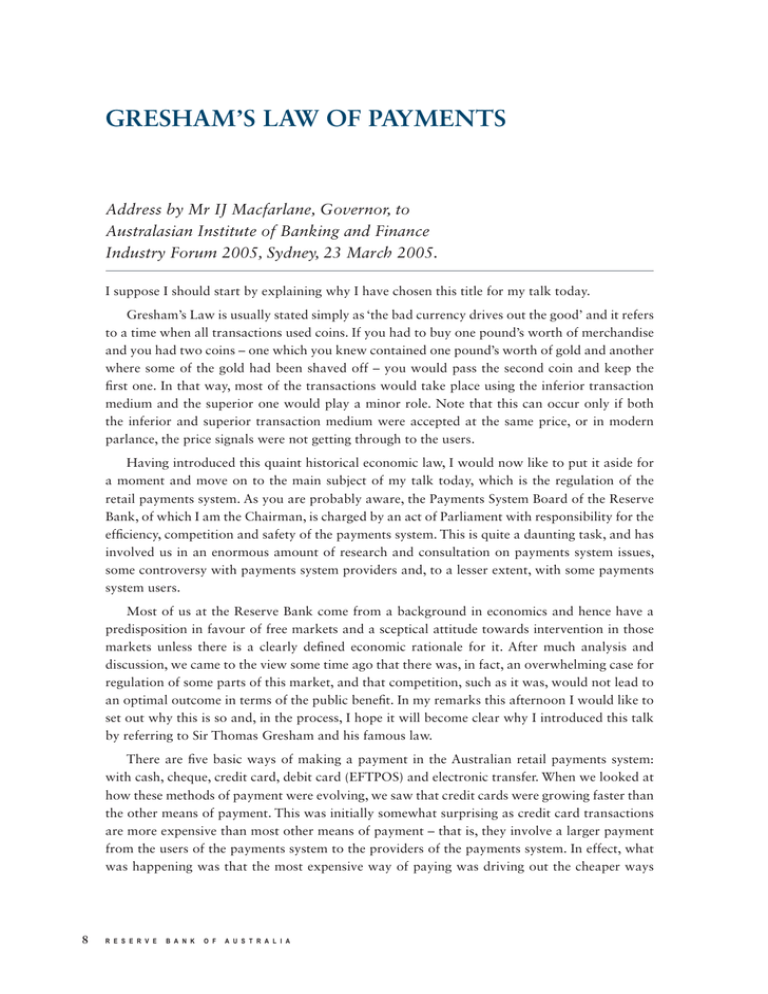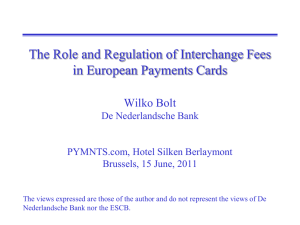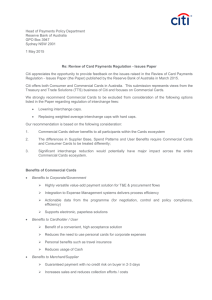GRESHAM’S LAW OF PAYMENTS
advertisement

GRESHAM’S LAW OF PAYMENTS Address by Mr IJ Macfarlane, Governor, to Australasian Institute of Banking and Finance Industry Forum 2005, Sydney, 23 March 2005. I suppose I should start by explaining why I have chosen this title for my talk today. Gresham’s Law is usually stated simply as ‘the bad currency drives out the good’ and it refers to a time when all transactions used coins. If you had to buy one pound’s worth of merchandise and you had two coins – one which you knew contained one pound’s worth of gold and another where some of the gold had been shaved off – you would pass the second coin and keep the first one. In that way, most of the transactions would take place using the inferior transaction medium and the superior one would play a minor role. Note that this can occur only if both the inferior and superior transaction medium were accepted at the same price, or in modern parlance, the price signals were not getting through to the users. Having introduced this quaint historical economic law, I would now like to put it aside for a moment and move on to the main subject of my talk today, which is the regulation of the retail payments system. As you are probably aware, the Payments System Board of the Reserve Bank, of which I am the Chairman, is charged by an act of Parliament with responsibility for the efficiency, competition and safety of the payments system. This is quite a daunting task, and has involved us in an enormous amount of research and consultation on payments system issues, some controversy with payments system providers and, to a lesser extent, with some payments system users. Most of us at the Reserve Bank come from a background in economics and hence have a predisposition in favour of free markets and a sceptical attitude towards intervention in those markets unless there is a clearly defined economic rationale for it. After much analysis and discussion, we came to the view some time ago that there was, in fact, an overwhelming case for regulation of some parts of this market, and that competition, such as it was, would not lead to an optimal outcome in terms of the public benefit. In my remarks this afternoon I would like to set out why this is so and, in the process, I hope it will become clear why I introduced this talk by referring to Sir Thomas Gresham and his famous law. There are five basic ways of making a payment in the Australian retail payments system: with cash, cheque, credit card, debit card (EFTPOS) and electronic transfer. When we looked at how these methods of payment were evolving, we saw that credit cards were growing faster than the other means of payment. This was initially somewhat surprising as credit card transactions are more expensive than most other means of payment – that is, they involve a larger payment from the users of the payments system to the providers of the payments system. In effect, what was happening was that the most expensive way of paying was driving out the cheaper ways 8 R E S E R V E B A N K O F A U S T R A L I A and, in the process, raising the average cost of the Australian retail payments system. Why was this possible? We concluded this was because there was an asymmetry between the price signals (and the capacity to act on them) faced by the two classes of payments system users – the cardholders and the merchants. For cardholders, the price signal they received was that credit card transactions were free, or could even result in receiving a payment in the form of ‘points’. Furthermore, cardholders were able to act on this signal as they were the party that chose the method of payment at the point of sale. Merchants, on the other hand, received a signal that the credit card was the most expensive way of making a payment (via the merchant service fee that was paid to their bank). But merchants had no power to influence the method of payment for the transaction – for that was in the hands of the cardholder. Thus, the incentives in the system were designed to encourage the decision-maker to choose the form of payment that was the most expensive from the perspective of society as a whole. Now it could be argued that merchants could have refused to accept credit cards in the first place. But that would have been a big decision, and the fact is that most merchants felt that they would forgo too many sales if they had taken that path (particularly if their competitors did not). They did not feel that they had much bargaining power vis-à-vis the credit card schemes and the banks. And until our recent reforms, they did not have the power to ‘pass on’ the merchant service fee to the customer, that is, employ the ‘user pays’ principle by insisting that if customers use an expensive means of payment they should pay more than if they use a cheaper one. Merchants now have that power as a result of our reforms, but in most cases they are reluctant to use it as the public have become accustomed to the old system and thus often resist the transition to user pays. In short, the asymmetry in price signals is still there despite our efforts to redress the imbalance by ‘empowering the merchants’. It is this asymmetry which is at the heart of the process whereby the more expensive means of payment expands at the expense of the less expensive. The mechanism that allows the asymmetry to be exploited is the system of fees that banks in the payments system pay one another – commonly known as interchange fees. In the case of credit cards, the fee is paid from the merchant’s bank to the cardholder’s bank on each transaction. These fees play an important role in determining the prices charged to both merchants and cardholders for payment services, yet they are not subject to the normal competitive forces that operate in most other markets. To the extent that competitive forces work at all, they perversely have had two effects: • they have encouraged the high-interchange-fee means of payment to grow at the expense of the low-interchange-fee one; • they have tended to push interchange fees up for the competing systems, not down. In this respect, the Australian experience is not unique. There are many examples around the world where these two effects are evident. I would like to illustrate this process by drawing on three examples, two of which are from the United States and the third from Australia. I am using US examples, not because examples do not exist elsewhere, but simply because legal cases in the United States have shone the spotlight B U L L E T I N | A P R I L 2 0 0 5 | A D D R E S S 9 on interchange fees more intensely than has been the case elsewhere, and because in many other countries interchange fees remain closely guarded secrets. Competition Between Credit Card Schemes The first example relates to the interchange fees in the MasterCard and Visa credit card systems in the United States, where over the past decade there have been a series of competitive increases in these fees (lower half of Graph 1). There is an incentive for each scheme to raise its interchange fee in order to encourage banks to issue its cards because the higher fee provides the issuing bank with more revenue. The Graph 1 issuing banks in turn use the revenue US Credit Card Merchant Service Fees to attract cardholders away from the and Interchange Fees scheme with the lower fee by offering $ $ Per $100 transaction cardholders more attractive pricing or more ‘reward points’. Once one 2.2 2.2 of the schemes raised interchange fees to give itself an advantage in Average merchant service fee attracting issuers and cardholders, 2.0 2.0 the other responded in the same way. The result has been that competition 1.8 1.8 amongst the schemes has seen fees increase from under 1.3 per cent 1.6 1.6 in 1994 to 1.65 per cent today – a perverse outcome to anyone with MasterCard interchange fee an economics background who 1.4 1.4 expects competition to lower prices. Visa interchange fee I might add that this is three times 1.2 1.2 the average level of interchange fees in Australia following the Reserve Bank’s reforms in 2003. 1.0 1.0 1994 1996 1998 2000 2002 2004 Of course the increase in US interchange fees has to be paid for by somebody. And, in the first instance, that somebody is the merchant, since interchange fees are built into the merchant service fee (what the merchant’s bank charges it for processing credit card transactions). Not surprisingly, average merchant service fees have increased broadly in line with the increase in interchange fees since the mid 1990s (upper half of Graph 1). Sources: MasterCard; Visa The end result is that merchants have to bear the extra costs of the competition between the credit card schemes. But, of course, the story does not stop here. Ultimately, higher merchant costs flow through into higher prices for the customers of those merchants. This is a cost borne by all consumers whether they use a credit card or not. 10 R E S E R V E B A N K O F A U S T R A L I A Competition Between Debit Card Schemes There is a similar story in the competition between two types of debit card systems in the United States. In one system, operated mainly as regional networks, transactions are authorised by PIN (the PIN-based systems), while in the other, operated by Visa and MasterCard, transactions are authorised by signature (the scheme-based systems). The interchange fee paid by the merchant’s bank to issuing banks is much higher in the scheme-based systems than the PIN-based systems (upper panel of Graph 2). As a result, issuing banks have been switching to the scheme-based systems and their share of the market has increased from 45 per cent to 60 per cent over the past decade (lower panel of Graph 2). The PIN-based schemes have retaliated to some extent, and their interchange fees have more than doubled over the decade, although they are still well below the scheme-based systems’ interchange fees. Once again, interchange fees have encouraged the growth of the relatively expensive payments system at the expense of the lowercost system, and forced the lowercost scheme to raise the price that is charged to merchants. Graph 2 US Interchange Fees on Debit Cards and Market Share $ $ Fee per $100 transaction 1.2 1.2 Scheme-based 0.8 0.8 0.4 0.4 PIN % % Scheme-based market share 60 60 50 50 40 1994 1996 2000 1998 2002 2004 40 Sources: MasterCard; Nilson Report; Visa There is an interesting additional twist to this story, and it concerns the question of why the merchants of America allowed this to happen? Why didn’t they resist more strongly the inroads into their profits caused by the expansion of the expensive system? Partly, of course, it was because they could pass the costs on to consumers in the form of higher prices, but there was an additional factor at work. This was the ‘tie-in’ arrangement imposed by Visa and MasterCard that forced any merchant accepting their credit cards to also accept their debit cards. By the mid 1990s, the merchants had become so upset by this rule that they took the credit card schemes to court – in what became known as the Wal-Mart case – arguing that the rule breached anti-trust laws. In April 2003, the case was finally settled, with Visa and MasterCard agreeing to abolish the rule, reduce the interchange fee, and pay damages of $3 billion to the merchants. B U L L E T I N | A P R I L 2 0 0 5 | A D D R E S S 11 Credit and Debit Cards in Australia This brings me back to where I started. In Australia, prior to the Bank’s recent reforms, the average interchange fee for a $100 transaction paid to a credit cardholder’s bank was 95 cents. In the Australian EFTPOS/debit card system,1 the interchange fee flows in the opposite direction and the cardholder’s bank has to pay around 20 cents per transaction to the merchant’s bank (upper panel of Graph 3). Given these flows, it is clear why card-issuing banks wanted to issue credit cards rather than EFTPOS cards – they received $1.15 more for each $100 transaction. Graph 3 Australian Interchange Fees and Card Payments per Capita $ $ Fee per $100 transaction 1.0 1.0 Credit 0.8 0.8 0.6 0.6 0.4 0.4 0.2 0.2 0.0 0.0 EFTPOS -0.2 No -0.2 No Payments per capita Per year 50 50 40 40 Credit cards EFTPOS/debit 30 30 20 20 10 10 0 1996 1998 2000 Sources: ABS; RBA 2002 2004 0 During the mid 1990s, the Australian banks worked hard at developing reward schemes (largely financed by their interchange fee receipts) to encourage cardholders to use credit cards. Reward points, together with interest-free credit, meant that many cardholders were being paid 1 per cent or more of the value of each transaction by credit card. Not surprisingly, there was a big shift towards credit cards, with transaction numbers growing at 20 to 30 per cent for around five years, while EFTPOS growth fell to less than 10 per cent per year (lower panel of Graph 3). As with the US experience, a higher-cost payments system was displacing a lower-cost one, and the community’s resources devoted to making payments increased. One of the longer-term aims of our reforms is to reduce the distortions in the payments system caused by the pattern of interchange fees. If large differences in the fees in the credit card and EFTPOS systems continue, it is hard to see why in the long run banks would continue to put resources into promoting the EFTPOS system. This is why we think that the merchants who oppose our EFTPOS reforms are extremely short-sighted. Without the proposed reforms, we could see a gradual withering away of the EFTPOS system, so that the merchants would face a larger and larger proportion of their sales taking place using the higher-cost credit card system. 1 Debit cards can be used to make purchases via the EFTPOS system or to withdraw cash from ATMs. In the following account of the Australian case, I will employ the widely-used term EFTPOS rather than debit card. I will ignore the other type of debit card – the Visa debit – because that has a separate set of characteristics, some of which are under separate regulatory review. 12 R E S E R V E B A N K O F A U S T R A L I A Back to Gresham’s Law It is pretty obvious by now where Gresham’s Law fits into my account, so I hardly need to spell it out. Instead of the bad currency driving out the good, we have the high-cost means of payment driving out the low-cost one. To take the most obvious example, a credit card offers the same service to a merchant – irrevocable payment – as a debit card, yet costs the merchant a lot more. To the cardholder, the credit card offers more – about 50 days free credit – yet it costs less, with the cardholder often receiving payment for using it. Clearly, the second condition for Gresham’s Law is met, namely that the price signals to the decision-maker do not reflect the underlying costs, that is the ‘user pays’ principle is not being applied. This tendency for competition to favour the high-cost product seems to be a feature of card-based systems around the world and explains the increasing attention given to the system by competition regulators. Before I finish, I would like to reassure you that in some other parts of the retail payments system, the normal laws of economics are leading to the normal results. The cheque provides the best illustration of this. All over the world the cheque – universally acknowledged as a relatively high-cost means of payment – is in decline, replaced by more efficient forms of electronic payment. The most important reason for this is that banks at both ends of the payments chain are charging their customers for the costs of writing and depositing cheques. So the ‘user pays’ principle works well in this case, but of course, there are no interchange fees. At the Reserve Bank, we are in favour of a retail payments system that provides users with a wide choice of options from a wide range of providers. Each payments method has its strengths and weaknesses, and so users should be able to choose the most suitable payments method for each particular type of transaction. In some cases the pricing of the transaction enables them to do so in a manner which contributes to an efficient low-cost retail payments system, while in some other cases it does not. The best way of improving efficiency is usually to increase competition rather than to regulate, but I think I have shown that some parts of the retail payments system are constructed in such a way that competition increases costs and reduces efficiency. In those areas, regulation is required, and the Reserve Bank through the Payments System Board will continue with its task of improving efficiency, competition and safety of the retail payments system. R B U L L E T I N | A P R I L 2 0 0 5 | A D D R E S S 13





